
13 minute read
COVER STORY — Set Sail with Seafood
seafoodSET SAIL WITH
| BY ANNELISE KELLY | One look at the globe reveals why seafood is beloved in Latin American cuisine. Nearly every country in the western hemisphere meets the sea, whether flanked by the Pacific Ocean, the Atlantic Ocean, the Gulf of Mexico or the Caribbean Sea. Mexico, with nearly 6,000 miles of coastline, is known for a robust shrimp fishing industry and plenty of celebrated seafood dishes such as snapper Veracruz and the iconic Baja fish taco. It’s worth noting that eating seafood is a traditional Catholic practice on holy days, which may have helped endear seafood to the region’s culinary heart.
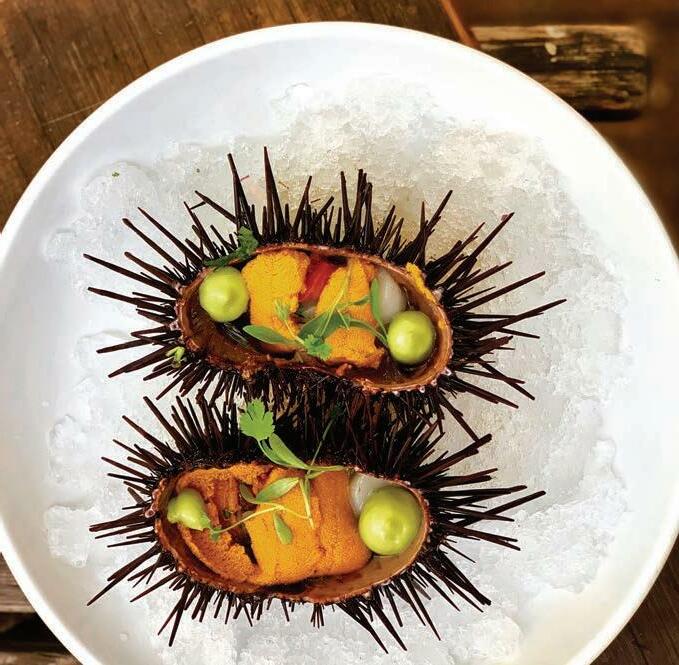
Holbox’s Ceviche de Erizo 7 Callo: Live Sea Urchin and Scallop Ceviche
According to its annual What’s Next in Mexican Cuisine trend forecast, Cacique Foods predicted that “2022 will be the year of mariscos … as foodies seek out authentic Mexican preparations such as aguachile, ceviche and more that let the flavors of fresh seafood shine.”
Seafood’s popularity has never been higher. At restaurants and grocery stores alike, consumers are increasingly choosing fish and shellfish. They perceive seafood to be a healthy and nutritious protein – and it’s a natural partner to the trend of eating less red meat. According to market research firm IRI, 41 percent of consumers want to consume more seafood in 2022, attracted in part by high protein, omega-3 content, and low fat. Datassential puts that number at 58 percent.
Savvy restaurant operators recognize that putting seafood on the menu is a smart move. Enticing seafood dishes appeal to meat-eaters
“Price is always a consideration considering our setting. We can’t go too crazy with our price point. So, we look to strike a balance with not-so-expensive local seafood — oftentimes overlooked and underutilized local seafood, things like live sea urchins and live spot prawns. Keeping the product here keeps our costs a little bit lower. And it also creates a fantastic network and relationships with these local fishermen or local farmers, strengthening our ability to obtain increasingly interesting local products.” – GILBERTO CETINA, Holbox and pescatarians alike, as well as customers looking for light, nutritious and healthy fare. Ranging from fish tacos to ceviche to platters of lobster or mahi-mahi, seafood dishes can be humble or lavish, lean or rich, ordinary or exotic, economical or indulgent. SEAFOOD ON THE MEXICAN MENU Traditional Mexican restaurants may specialize in mariscos (which translates to shellfish, but
City Taco’s Camarón Enchilado Taco
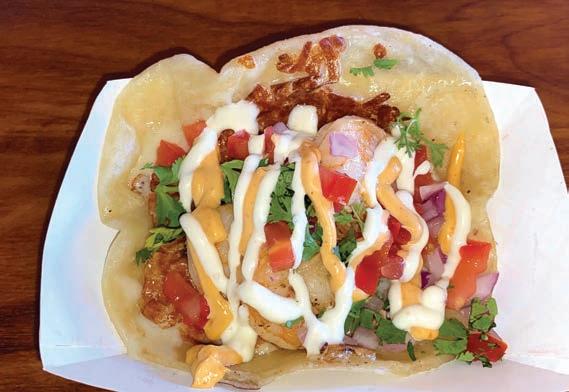
– WHAT’S NEXT IN MEXICAN
CUISINE TREND FORECAST, Cacique Foods more generally refers to seafood). Classic presentations include grilled and sautéed fin fish and shrimp; cold shrimp or mixed seafood cocktail in a zingy tomato-based sauce; tacos with battered, fried fish and shredded cabbage; and shrimp enchiladas. Some Mexican restaurants take a more upscale approach, which often reveals itself in ceviches and higher-end seafood such as octopus, lobster, spot prawns, halibut, salmon, swordfish, and more.
Flor de Maiz, a beachfront restaurant in Santa Barbara, California, offers colorful, upscale seafood such as Mejillones Vapor (steamed mussels) in white wine and garlic mojo sauce. The restaurant’s quasi-raw offerings include Ceviche de Pulpo with sliced octopus, grilled pineapple, and fresh coconut; Atún Toreado, ahi tuna with salsa ponzu toreada; and Tiradito de Salmon al Achiote, thinly sliced raw salmon with citrus achiote sauce. Shrimp and lobster empanadas are on the appetizer side and tacos include fried soft shell crab, lobster claw meat, octopus and shrimp. On the entrée menu, find Mole Verde con Halibut and Pulpo al Pesto, grilled octopus marinated in santa leaf pesto with creamy huitlacoche rice.
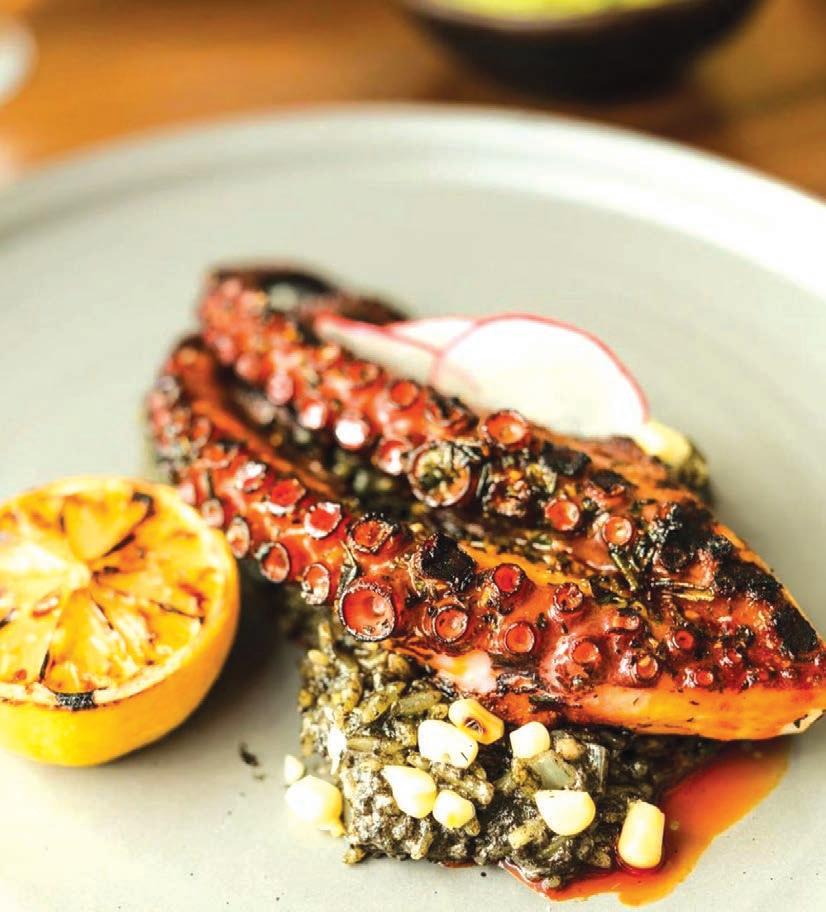
Flor de Maiz’s Pulpo al Pesto
UPSCALE MENU IN FOOD COURT SETTING
Holbox in Los Angeles defies expectations with ambitious upscale fare despite being a fast-casual, order-at-the-counter establishment in Mercado la Paloma, a food hall/market located in a converted garment factory in South Los Angeles. This spin-off from Chichen Itza, a Yucatecan restaurant in the same
Holbox’s Camarones al Mojo de Ajo with @transparentseafarm shrimp
building, is 100 percent dedicated to seafood. Chef/owner Gilberto Cetina intended to open a casual ceviche bar with a few options, but it’s turned into a fish-fanatics destination where the half-dozen ceviches include wild-caught Mexican shrimp, octopus, bay scallops, and uni (sea urchin) along with

Sustainable Seafood: AN IMPORTANT COMPONENT OF MENU PLANNING
The soaring demand for seafood and the increasing global population translate to serious pressures on wild fish. Sustainability is a critical concern to operators as well as diners. The percentage of seafood shoppers who care about sustainability climbed from 29 percent in 2019 to 41 percent in 2021, according to the 2021 FMI Power of Seafood Report/Nielsen IQ. Scientifically managed fisheries and seafood farming are two ways to mitigate this pressure.
“Sustainability is really trending right now and that’s for good reason,” says Leah Krafft, domestic marketing manager for the Alaska Seafood Marketing Institute. “It’s better for the planet. It’s better for the body and the menu. We have a data point that shows 78 percent of consumers agree that sustainability is a motivator when choosing seafood over other proteins.”
The science is clear. Overfishing has dramatically depleted fish populations, and warming oceans are further threatening the fauna and flora of the sea. Nearly 80 percent of the world’s fisheries are in jeopardy or collapse, and 90 percent of large predatory fish are gone. Statistics suggest that if the fishing industry doesn’t change, fish populations will be functionally extinct by 2048.
What can we do? One answer lies in sustainably managed fisheries, which all fisheries in Alaska are, according to Krafft.
A central part of sustainable management is careful monitoring of fish populations and of the fishing industry. Limiting the season and catch volumes, utilizing the whole catch, and limiting bycatch (unwanted fish caught along with the target fish) all play critical roles. Fish farming and aquaculture also can help preserve wild fish populations; but all fish farming is not created equal. Farming Atlantic salmon in coastal Pacific water, for example, is problematic for a variety of reasons, and many inland and coastal shrimp farms cause significant environmental problems. However, thoughtful and regulated farming of fish can benefit consumers, communities and the environment.
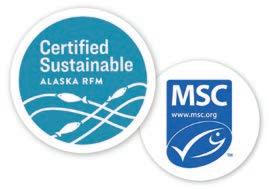
WHAT RESTAURANTS CAN DO
There are several ways restaurateurs and chefs tasked with selecting seafood for their menus can begin the journey toward making their choices sustainable ones. • Get educated about options and rely on respected resources to evaluate whether a specific seafood fishery complies with sustainability practices. Some resources to explore include The Marine Stewardship Council (MSC), which certifies commercial fisheries and acquaculture to confirm environmentally and socially responsible practices, and the
Monterey Bay Aquarium
Seafood Watch program, which is designed to helps businesses and consumers make choices for a healthy ocean. • Consider sourcing product from fisheries that have
Responsible Fisheries
Management (RFM) Certification. The RFM program provides documented third-party assurance of responsible seafood sourcing policies. • Buy local to support and reinforce distribution networks in your area. • Develop a relationship with a trusted fish supplier, express interest in sustainable seafood and ask them to notify you when new sustainable products become available.
spot prawns, smoked kanpachi, oysters, clams, local spiny lobster, whole grilled branzino, and more. Holbox even offers a $95 sixcourse tasting menu at the small counter so the chef can pull out all the stops with small plates such as geoduck sashimi and a smoked Dungeness crab taco with crab butter salsa.
“When we first opened, our focus was not to do a sustainable seafood restaurant,” says Cetina. However, he soon discovered “the sustainable stuff is the tastiest.” Holbox uses both wild-caught and farmed seafood.
“Price is always a consideration considering our setting. We can’t go too crazy with our price point. So, we look to strike a balance with not-so-expensive local seafood — oftentimes overlooked and underutilized local seafood, things like live sea urchins and live spot prawns.” He points out that lots of quality product is shipped overseas, so it’s critical to “support the local economy, the local fisheries, the local co-ops, and give them an option other than selling it to the highest overseas bidder. Keeping the product here keeps our costs a little bit lower. And it also creates a fantastic network and relationships with these local fishermen or local farmers, strengthening our ability to obtain increasingly interesting local products.” Farmed shrimp are delivered from TransparentSea, an urban aquaculture enterprise tucked behind Pizza Hut and Goodwill just 15 miles away.
In terms of trends, Cetina says octopus, sourced from the Gulf of

Flor de Maiz’s Salmon Tiradito “Tiradito is one of the newest trends in Latin-inspired cuisine. In the Valle de Guadalupe [a wine region in northern Baja California], pretty much every restaurant has tiradito on the menu.”
– GERRY TORRES, City Tacos
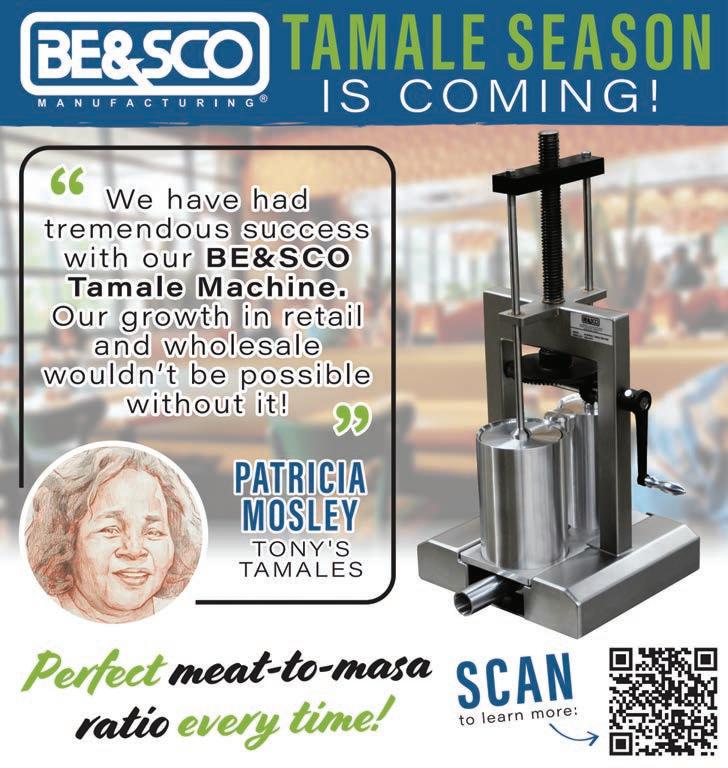
CLASSIC LATIN AMERICAN SEAFOOD DISHES
Mexico may dominate the Latin American food scene in the U.S., but other cuisines from South and Central America have rich seafood traditions as well.
BACALAITOS, Puerto Rico: Flat, crispy codfish fritters.
BOBÓ DE CAMARÃO, Brazil: This stew includes puréed cassava along with shrimp and coconut milk. Rice is served on the side.
CEVICHE, Peru: Ceviche is raw seafood marinated in citrus, which cooks it chemically, typically with chiles and onions as well. In Peruvian tradition it’s generally served garnished with corn and potatoes or sweet potatoes.
CURANTO, Chile: In a tradition similar to a New England clam bake, meat, shellfish, potato dumplings and vegetables are cooked in a pit lined with hot stones, then served with pebre (a Chilean salsa) and milcaos (potato pancakes).
ENCEBOLLADO, Ecuador: The nation’s national dish is fish soup characterized by a large quantity of onions. The soup starts with sofrito including tomatoes, onions, chili, coriander, and cumin, then cassava root, tomatoes, onions and pickled onions are added.
MAITO DE PESCADO, Equador: This traditional Ecuadorian dish consists of river fish wrapped in banana leaves and cooked over fire. It’s served with cassava, plantains, or potatoes on the side.
MOQUECA, Brazil: This rich seafood stew incorporates palm oil and coconut milk with fish and/or shrimp. It’s traditionally stewed in clay pots and served over rice.
PAELLA, Cuba: Cuba’s Spanish/Moorish heritage is reflected in this ricebased dish featuring sausage, assorted shellfish, and saffron.
PAILA MARINA, Chile: This flavorful traditional stew starts with a shellfish stock, joined by a variety of seafood, shellfish, herbs, spices, and vegetables such as tomatoes, bell peppers, carrots, and onions.
PARIHUELA, Peru: This spicy, hearty seafood stew reflects the coastal fishing communities where it originated, so it can incorporate virtually any seafood, along with signature chiles such as ají panca, ají amarillo and ají rocoto. Ginger, cumin, cilantro, and lime juice deliver a fragrant finish.
TIRADITO, Peru: Probably influenced by Japanese immigrants, tiradito is thinly sliced raw fish usually drizzled with a light citrus-based dressing right before serving.
TRUCHA A LA PARRILLA, Argentina: Trout grilled over coals, often lightly seasoned with lemon juice, cumin, and garlic.
Mexico, is very popular, and “Southern California loves sea urchin. We have some of the best urchin in the world from Santa Barbara.” He also embraces the “tail to scale” philosophy, using the whole fish by making fish sausages and smoking the heads of Kampachi. The picked-off meat is transformed into a guisado and spread on a tostada, topped by ceviche-style shrimp or scallops. While much of the menu reflects traditional techniques and combinations, he also busts some bold moves such as topping that tostada with an arbol-peanut-soy sauce — “100 percent untraditional.”
FAST-CASUAL TACOS WITH DELUXE SEAFOOD FILLINGS
At City Tacos in San Diego, a fastcasual chain with seven locations, creative touches entice diners. Tacos include the Scallop Dreams, with pepper cream flambéed scallops topped with Mexican squash, bacon and cotija cheese; the Crunch Time Shrimp Taco, with bacon and cheese; and the very popular Camarón Enchilado, featuring grilled shrimp with chile de arbol. The Pescado Taco takes an unexpected fruity turn: golden-fried mahi-mahi is topped with cabbage, tomatoes, pickled red onions, habanero and strawberries.
Founder Gerry Torres launched City Tacos in 2014 and has 30 years of history in the restaurant business. With supply chains stretched thin, Torres says the seafood that makes it onto the menu depends “on what’s available lately.
“For example, our bluefin tuna is a take on smoked marlin, which was pretty much fished out of the ocean. Our bluefin is sustainable — it’s actually humanely farm-raised in the ocean off Ensenada and it’s eco-friendly,” he explains.
Torres relies on farm-raised shrimp for most of his menu, but the Crunch Time Shrimp Taco depends on the more robust flavor of wild-caught shrimp. For farmed products, he examines the companies critically for environmental impact. “With oversight, farm-raised seafood can be a great thing and can actually help bring our oceans back to health.”
His take on the trends: Customers gravitate to the freshness and supreme quality of ceviche and tiradito, thinly sliced fresh catch marinated with citrus. “Tiradito is one of the newest trends in Latin-inspired cuisine. In the Valle de Guadalupe [a wine region in northern Baja California], pretty much every restaurant has tiradito on the menu.” Products like sushi-grade raw fish and scallop tacos can fetch a higher price and “bring up the quality of your establishment.”
With seafood’s popularity booming and costs increasing, Torres has had to take an obvious but obviously unwanted step. “We’ve had to raise prices to match what we’re purchasing so we’re able to turn a profit,” he says. “But, while it’s definitely rising in price like everything else, I think seafood held up a bit better than meat did during the pandemic. Meats really skyrocketed in price, somewhere around 50 to 60 percent, while seafood didn’t climb that much — maybe a 20 percent increase in seafood prices.”
Latin and Mexican restaurants at every level of service, from food trucks to fine dining, can benefit by incorporating seafood into their menus. With its competitive price point, popularity, and high perceived value to health-oriented, environmentally conscious diners, some strategically conceived and executed fish and shellfish dishes will please customers, diversify your offerings, and potentially benefit your bottom line.

Annelise Kelly, a freelance writer based in Portland, Oregon, is a frequent contributor to el Restaurante.
Family owned and operated for fifty years. The Rovey brand has become a trusted source of non-GMO and organic food grade grains and ingredients. Non-GMO & organic white, yellow, blue and red corn perfect for tortillas.
SPECIALTY SOYBEANS AND FOOD GRADE WHITE & YELLOW CORN
QUALITY FOOD GRADE AND SPECIALTY GRAINS


2022 Our 25,000+ readers want information about your products!
elRestaurante | YOUR SOURCE FOR MEXICAN AND LATIN FOODSERVICE TRENDS | www.elrestaurante.com | JULY/AUGUST 2022
It’s our 25th anniversary! We hope you’ll join us in celebrating this milestone year and promote your products to our loyal base of readers, who represent the heart of the Mexican/Latin restaurant industry in the United States.

TWO MORE GREAT ISSUES IN 2022!

SEPTEMBER/OCTOBER
• COVER STORY: Salsas and Guacamole
• BUSINESS BASICS: Food Safety in the
Spotlight
• AT THE BAR: Mexican Liqueurs
Set Sail with SEAFOOD Spike It! Aguas Fresca & Horchata Behind the Bar Build Sales with Social Media
NOVEMBER/DECEMBER
• OUR ANNUAL BUYER’S GUIDE, WITH SPECIAL OFFERS FOR ADVERTISERS!
• COVER STORY: Appetizers & Sides • SPECIAL REPORT: 8th Annual Independent
Mexican Restaurant Report • BUSINESS BASICS: Maximizing Online
Ordering • AT THE BAR: Holiday Cocktails • AD CLOSE: October 28, Materials Due:
November 2
• AD CLOSE: August 25,
Materials Due: September 6 And in every issue…Hotline, Marketplace, My Favorite Recipe and More!









